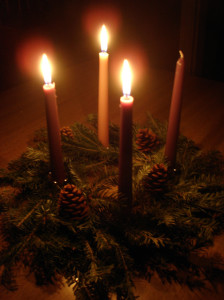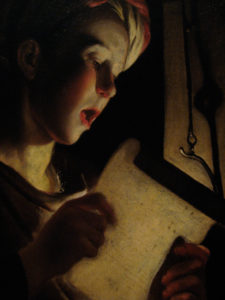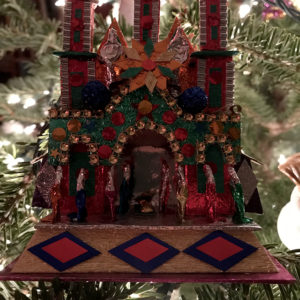I was chatting with a friend over the long Thanksgiving weekend who told me she was feeling like it was already too late to bother with Christmas. “But we still have another week of November,” I said. Christmas is a long ways away. Still, I understand how it’s easy to perceive that it’s all passing you by already. And so it seems a good time to reprint this particular chapter of the Convivio Book of Days. It was first published on the 17th of November, 2013. But the words are timely now on our approach to Advent, which itself marks the approach to Christmas. So breathe deep, take a few moments to read these few lines, and be reminded that all is well––there is plenty of time to do all you want to do this holiday season, and the slower you take it, the more content you just may be.
*
My neighbor Mr. Solderholm is a grumpy old Swede who can easily muster up a rant over just about anything. A good guy when you get right down to it, but you don’t want to get in his way or cross him, even accidentally. I am nothing like Mr. Solderholm and we both know this and we respect each other’s ways, but if there is one time of year where I sense a bit of Solderholm-style ire creep into my being, it’s usually about now: I find myself grumbling and shaking my fist at houses that are all decked out for Christmas in mid-November, a season for Indian corn and pumpkins, not holly and balsam. I think it’s because I am always championing the little guy, and Thanksgiving, it seems to me, is one of those little guys: an all around nice holiday that gets a bit trampled by the bigger holiday that follows it. I do not, however, want to be as disagreeable as Mr. Solderholm. What I want is to encourage folks to give Thanksgiving its due and to take the rest as it comes.
Today’s installment of the Book of Days is simply an invitation to you all: Join us in what we call “The Slow Christmas Movement.” Rather than rush headlong into Christmas the day after Thanksgiving (or even earlier), we invite you to take your time and appreciate the approach.
What comes after Thanksgiving and before Christmas is Advent: a time of preparation. We prepare our houses, we prepare ourselves––heart, mind, soul––we set the stage for joy to enter at Christmas by making it welcome and appreciating its presence. There are songs for Advent, our favorite being a carol called “People, Look East” that is set to an old French air known as Besançon. These are the lyrics for the first verse:
People, look east. The time is near
Of the crowning of the year.
Make your house fair as you are able,
Trim the hearth and set the table.
People, look east and sing today:
Love, the guest, is on the way.
It may be my instinctual desire for things domestic that makes me like that carol so much. If there was a verse about polishing the copper, I’d be right at home. What that carol speaks of, mostly, is preparing, and I think preparing is an important part of ceremony and celebration… which may be why I like Advent so much.
My grandparents used to get their Christmas tree on Christmas Eve. This is most traditional, and while Seth and I don’t wait quite that long, we are usually visiting our friends at the tree lot quite a bit later than most people. Here’s what you’ll see at our house before the tree arrives: candles in the windows, and an Advent calendar and Advent candles nearby. We light the traditional Advent wreath each of the four Sundays of Advent, we light a daily Advent candle each evening during dinner, and we open a window of our Advent calendar each evening, too. These are slow, simple and meaningful ways to mark the days as we approach the solemnity and the celebration of Christmas… which, of course, begins its own twelve days of celebration.
What’s odd nowadays is that the dominant culture celebrates Christmas before it actually begins, and then shuts things down well before Christmas is over. Old Mr. Solderholm once punched a man in the nose for tossing out his Christmas tree on the 26th of December. Granted, there were some other things going on between them, too, but it was the tree on the curb that instigated the argument that finally pushed Mr. Solderholm over the edge. And while I would never go as far as to punch a man in the nose over anything, there is a part of me that applauded Mr. Solderholm for that act as he stood up to defend the sanctity of old traditions. We may not see eye to eye on most things, he and I, but we do seem to agree on the importance of taking things slowly and respecting the traditions of the ceremonies we keep.
The Slow Christmas Movement means keeping Thanksgiving and keeping it well and keeping Christmas, too, but in its own time. Do so and here’s something else that happens: you almost magically have more time to enjoy everything. Thanksgiving retains its independence, Advent prepares you for “Love, the guest,” and sure, there may still be a frantic rush to the 25th of December… but once it has passed, there are twelve days of Christmas still ahead to celebrate with good food, good company, and good spirit. There is no rush.
*
At our online shop, www.conviviobookworks.com, you’ll find all kinds of traditional German Advent calendars (the ones with lots of glitter you remember from your childhood) as well as British ones, and some very lovely Advent candles, handmade in England. These simple things are a big part of our Slow Christmas Movement and a reason why in this house we appreciate Christmas as much as we do. (Free domestic shipping, by the way, when you spend $50 in our shop!)
FIND US on Saturday, December 1 from 10 AM to 4 PM at the Midwinter Makers Marketplace at Florida Atlantic University in Boca Raton. Free admission, free easy parking, live music, letterpress printing and crafts for the kids, plus we’re supplying the amazing doughnuts and the Louie Bossi’s Wood Burning Oven Pizza Truck will be there, too, and you’ll find about 20 local makers selling their wares. We’ll be there with our Advent offerings and plenty of great handmade stuff for Christmas, plus our full line of culinary herbs and herbal teas from the Sabbathday Lake Shaker Community in Maine. Follow the blue and white MAKERS MARKETPLACE signs posted on FAU campus roads to the Satellite Studios of the Jaffe Center for Book Arts, located at FAU’s historic T6 Building on the northeast corner of campus.


